Optimize Short-Term Rainfall Forecast with Combination of Ensemble Precipitation Nowcasts by Lagrangian Extrapolation
Abstract
1. Introduction
2. Theoretical Framework
2.1. Ensemble Forecast and the Lagged Average Forecast
2.2. Method of Averaging
2.3. Optimal Number of Ensemble Members and Quality of Ensemble Forecast
3. Data
3.1. Rainfall Forecast of MAPLE
3.2. Storm Events
4. Results
4.1. Weighted Average Ensemble Forecast
4.2. Quality of Weighted Average Ensemble Forecast
5. Summary and Conclusions
Author Contributions
Funding
Conflicts of Interest
References
- United Nations (UN). World Urbanization Prospects: The 2007 Revision; Department of Economic and Social Affairs, Population Division, UN: New York, NY, USA, 2008. [Google Scholar]
- Kalnay, E.; Cai, M. Impact of urbanization and land-use change on climate. Nature 2003, 423, 528–531. [Google Scholar] [CrossRef] [PubMed]
- Satterthwaite, D. Cities’ contribution to global warming: Notes on the allocation of greenhouse gas emissions. Environ. Urban. 2008, 20, 539–549. [Google Scholar] [CrossRef]
- Satterthwaite, D. The implications of population growth and urbanization for climate change. Environ. Urban. 2009, 21, 545–567. [Google Scholar] [CrossRef]
- Zhou, L.M.; Dickinson, R.E.; Tian, Y.H.; Fang, J.Y.; Li, Q.X.; Kaufmann, R.K.; Tucker, C.J.; Myneni, R.B. Evidence for a significant urbanization effect on climate in China. Proc. Natl. Acad. Sci. USA. 2004, 101, 9540–9544. [Google Scholar] [CrossRef] [PubMed]
- Kron, W. Flood risk = hazard• values• vulnerability. Water Int. 2005, 30, 58–68. [Google Scholar] [CrossRef]
- Nicholls, S. Climate change, tourism and outdoor recreation in Europe. Manag. Leis. 2006, 11, 151–163. [Google Scholar] [CrossRef]
- Steiger, R.; Abegg, B.; Jänicke, L. Rain, rain, go away, come again another day. Weather preferences of summer tourists in mountain environments. Atmosphere 2016, 7, 63. [Google Scholar] [CrossRef]
- Intergovernmental Panel on Climate Change (IPCC). Climate Change 2007: The Physical Science Basis: Summary for Policymakers; IPCC: Geneva, Switzerland, 2007. [Google Scholar]
- Coumou, D.; Rahmstorf, S. A decade of weather extremes. Nat. Clim. Change 2012, 2, 491. [Google Scholar] [CrossRef]
- Groisman, P.Y.; Knight, R.W.; Karl, T.R.; Easterling, D.R.; Sun, B.; Lawrimore, J.H. Contemporary changes of the hydrological cycle over the contiguous United States: Trends derived from in situ observations. J. Hydrometeorol. 2004, 5, 64–85. [Google Scholar] [CrossRef]
- Knutson, T.R.; McBride, J.L.; Chan, J.; Emanuel, K.; Holland, G.; Landsea, C.; Held, I.; Kossin, J.P.; Srivastava, A.; Sugi, M. Tropical cyclones and climate change. Nat. Geosci. 2010, 3, 157. [Google Scholar] [CrossRef]
- Trenberth, K.E. Changes in precipitation with climate change. Clim. Res. 2011, 47, 123–138. [Google Scholar] [CrossRef]
- Georgakakos, K.P. On the design of national, real-time warning systems with capability for site-specific, flash-flood forecasts. Bull. Am. Meteorol. Soc. 1986, 67, 1233–1239. [Google Scholar] [CrossRef]
- Jonkman, S.N. Global perspectives on loss of human life caused by floods. Nat. Hazards 2005, 34, 151–175. [Google Scholar] [CrossRef]
- National Weather Service (NWS). NCRFC Flash Flood Guidance; Office of Hydrologic Development, National Weather Service, National Oceanic and Atmospheric Administration: Silver Spring, MD, USA, 1998. [Google Scholar]
- American Meteorological Society (AMS). Policy statement: Prediction and mitigation of flash floods. Bull. Am. Meteor. Soc. 2000, 81, 1338–1340. [Google Scholar] [CrossRef]
- Sweeney, T.L. Modernized Areal Flash Flood Guidance; National Oceanic and Atmospheric Administration: Silver Spring, MD, USA, 1992. [Google Scholar]
- Georgakakos, K.; Graham, R.; Jubach, R.; Modrick, T.; Shamir, E.; Spencer, C.; Sperfslage, J. Global Flash Flood Guidance System, Phase I. HRC Technical Report; Hydrologic Research Center: San Diego, CA, USA, 2013. [Google Scholar]
- Smith, P.; Pappenberger, F.; Wetterhall, F.; del Pozo, J.T.; Krzeminski, B.; Salamon, P.; Muraro, D.; Kalas, M.; Baugh, C. On the Operational Implementation of the European Flood Awareness System (EFAS). In Flood Forecasting: A Global Perspective; Academic Press: Cambridge, MA, USA, 2016; pp. 313–348. [Google Scholar]
- Korea Meteorological Administration (KMA). Development of Monitoring and Prediction Technology for Severe Weather (Heavy Rainfall) over the Korean Peninsula; KMA: Seoul, Korea, 2006. [Google Scholar]
- National Disaster Management Research Institue (NDMI). Advancement of Mountain Flash Flood Prediction System & Development of Decision-Making Supporting System; NDMI: Seoul, Korea, 2010. [Google Scholar]
- Mueller, C.; Saxen, T.; Roberts, R.; Wilson, J.; Betancourt, T.; Dettling, S.; Oien, N.; Yee, J. NCAR auto-nowcast system. Weather Forecast. 2003, 18, 545–561. [Google Scholar] [CrossRef]
- Dixon, M.; Wiener, G. TITAN: Thunderstorm identification, tracking, analysis, and nowcasting—A radar-based methodology. J. Atmos. Ocean. Technol. 1993, 10, 785–797. [Google Scholar] [CrossRef]
- Saito, K.; Fujita, T.; Yamada, Y.; Ishida, J.-I.; Kumagai, Y.; Aranami, K.; Ohmori, S.; Nagasawa, R.; Kumagai, S.; Muroi, C. The operational JMA nonhydrostatic mesoscale model. Mon. Weather Rev. 2006, 134, 1266–1298. [Google Scholar] [CrossRef]
- Terada, M. The Development of Short-Term Rainfall Prediction System in Mountainous Region by the Combination of Extrapolation Model and Mesoscale Atmosphereic Model. In Proceedings of the 6th International Symposium on Hydrological Applications of Weather Radar, Melbourne, Australia, 2–4 February 2004. [Google Scholar]
- Korea Meteorological Administration (KMA). Study on the Weather Radar Application (II); KMA: Seoul, Korea, 2008. [Google Scholar]
- Germann, U.; Zawadzki, I. Scale-dependence of the predictability of precipitation from continental radar images. Part I: Description of the methodology. Mon. Weather Rev. 2002, 130, 2859–2873. [Google Scholar] [CrossRef]
- Radhakrishna, B.; Zawadzki, I.; Fabry, F. Predictability of precipitation from continental radar images. Part V: Growth and decay. J. Atmos. Sci. 2012, 69, 3336–3349. [Google Scholar] [CrossRef]
- National Institute of Meteorological Sciences (NIMS). Development of Very Short-Range Prediction System for Severe Weather; NIMS: Seoul, Korea, 2009. [Google Scholar]
- Zahrei, A.; Hsu, K.L.; Sorroshian, S.; Gourley, J.J.; Lakshmanan, V.; Hong, Y.; Bellerby, T. Quantitative precipitation nowcasting: A Lagrangian pixel-based approach. Atmos. Res. 2012, 118, 418–434. [Google Scholar] [CrossRef]
- Wang, G.; Wong, W.; Hong, Y.; Liu, L.; Dong, J.; Xue, M. Improvement of forecast skill for severe weather by merging radar-based extrapolation and storm-scale NWP corrected forecast. Atmos. Res. 2015, 154, 14–24. [Google Scholar] [CrossRef]
- Yu, W.; Nakakita, E.; Kim, S.; Yamaguchi, K. Improvement of rainfall and flood forecasts by blending ensemble NWP rainfall with radar prediction considering orographic rainfall. J. Hydrol. 2015, 531, 494–507. [Google Scholar] [CrossRef]
- Migliorini, S.; Dixon, M.; Bannister, R.; Ballard, S. Ensemble prediction for nowcasting with a convection-permitting model—I: Description of the system and the impact of radar-derived surface precipitation rates. Tellus A Dyn. Meteorol. Oceanogr. 2011, 63, 468–496. [Google Scholar] [CrossRef][Green Version]
- Done, J.; Craig, G.; Gray, S.; Clark, P.A. Case-to-case variability of predictability of deep convection in a mesoscale model. Q. J. R. Meteorol. Soc. 2012, 138, 638–648. [Google Scholar] [CrossRef]
- Kühnlein, C.; Keil, C.; Craig, G.; Gebhardt, C. The impact of downscaled initial condition perturbations on convective-scale ensemble forecasts of precipitation. Q. J. R. Meteorol. Soc. 2014, 140, 1552–1562. [Google Scholar] [CrossRef]
- Molteni, F.; Buizza, R.; Palmer, T.N.; Petroliagis, T. The ECMWF ensemble prediction system: Methodology and validation. Q. J. R. Meteorol. Soc. 1996, 122, 73–119. [Google Scholar] [CrossRef]
- Hewitt, C.D. Ensembles-based predictions of climate changes and their impacts. Eos Trans. Am. Geophys. Union 2004, 85, 566. [Google Scholar] [CrossRef]
- Hanley, K.; Kirshbaum, D.; Belcher, S.; Roberts, N.; Leoncini, G. Ensemble predictability of an isolated mountain thunderstorm in a high-resolution model. Q. J. R. Meteorol. Soc. 2011, 137, 2124–2137. [Google Scholar] [CrossRef]
- Kober, K.; Craig, G.; Keil, C.; Dörnbrack, A. Blending a probabilistic nowcasting method with a high-resolution numerical weather prediction ensemble for convective precipitation forecasts. Q. J. R. Meteorol. Soc. 2012, 138, 755–768. [Google Scholar] [CrossRef]
- Richardson, D.S. Skill and relative economic value of the ECMWF ensemble prediction system. Q. J. R. Meteorol. Soc. 2000, 126, 649–667. [Google Scholar] [CrossRef]
- Marsigli, C.; Boccanera, F.; Montani, A.; Paccagnella, T. The COSMO-LEPS mesoscale ensemble system: Validation of the methodology and verification. Nonlinear Process. Geophys. 2005, 12, 527–536. [Google Scholar] [CrossRef]
- Bowler, N.E.; Arribas, A.; Mylne, K.R.; Robertson, K.B.; Beare, S.E. The MOGREPS short-range ensemble prediction system. Q. J. R. Meteorol. Soc. 2008, 134, 703–722. [Google Scholar] [CrossRef]
- Kay, J.K.; Kim, H.M.; Park, Y.-Y.; Son, J. Effect of doubling the ensemble size on the performance of ensemble prediction in the warm season using MOGREPS implemented at the KMA. Adv. Atmos. Sci. 2013, 30, 1287–1302. [Google Scholar] [CrossRef]
- Dalchér, A.; Kalnay, E.; Hoffman, R.N. Medium range lagged average forecasts. Mon. Weather Rev. 1988, 116, 402–416. [Google Scholar] [CrossRef]
- Branković, Č.; Palmer, T.; Molteni, F.; Tibaldi, S.; Cubasch, U. Extended-range predictions with ECMWF models: Time-lagged ensemble forecasting. Q. J. R. Meteorol. Soc. 1990, 116, 867–912. [Google Scholar] [CrossRef]
- Mittermaier, M.P. Improving short-range high-resolution model precipitation forecast skill using time-lagged ensembles. Q. J. R. Meteorol. Soc. 2007, 133, 1487–1500. [Google Scholar] [CrossRef]
- Scheufele, K.; Kober, K.; Craig, G.C.; Keil, C. Combining probabilistic precipitation forecasts from a nowcasting technique with a time-lagged ensemble. Meteorol. Appl. 2014, 21, 230–240. [Google Scholar] [CrossRef]
- Buizza, R.; Tribbia, J.; Molteni, F.; Palmer, T. Computation of optimal unstable structures for a numerical weather prediction model. Tellus A 1993, 45, 388–407. [Google Scholar] [CrossRef]
- Toth, Z.; Kalnay, E. Ensemble forecasting at NMC: The generation of perturbations. Bull. Am. Meteorol. Soc. 1993, 74, 2317–2330. [Google Scholar] [CrossRef]
- Evensen, G. Sequential data assimilation with a nonlinear quasi-geostrophic model using Monte Carlo methods to forecast error statistics. J. Geophys. Res. Oceans 1994, 99, 10143–10162. [Google Scholar] [CrossRef]
- Houtekamer, P.; Derome, J. Methods for ensemble prediction. Mon. Weather Rev. 1995, 123, 2181–2196. [Google Scholar] [CrossRef]
- Kuczera, G.; Parent, E. Monte Carlo assessment of parameter uncertainty in conceptual catchment models: The Metropolis algorithm. J. Hydrol. 1998, 211, 69–85. [Google Scholar] [CrossRef]
- Gebhardt, C.; Theis, S.; Paulat, M.; Bouallègue, Z.B. Uncertainties in COSMO-DE precipitation forecasts introduced by model perturbations and variation of lateral boundaries. Atmos. Res. 2011, 100, 168–177. [Google Scholar] [CrossRef]
- Shiogama, H.; Watanabe, M.; Ogura, T.; Yokohata, T.; Kimoto, M. Multi-parameter multi-physics ensemble (MPMPE): A new approach exploring the uncertainties of climate sensitivity. Atmos. Sci. Lett. 2014, 15, 97–102. [Google Scholar] [CrossRef]
- Duan, Q.; Ajami, N.K.; Gao, X.; Sorooshian, S. Multi-model ensemble hydrologic prediction using Bayesian model averaging. Adv. Water Resour. 2007, 30, 1371–1386. [Google Scholar] [CrossRef]
- Boer, G.; Lambert, S. Multi-model decadal potential predictability of precipitation and temperature. Geophys. Res. Lett. 2008, 35. [Google Scholar] [CrossRef]
- Fowler, H.; Ekström, M. Multi-model ensemble estimates of climate change impacts on UK seasonal precipitation extremes. Int. J. Climatol. 2009, 29, 385–416. [Google Scholar] [CrossRef]
- Mailhot, A.; Beauregard, I.; Talbot, G.; Caya, D.; Biner, S. Future changes in intense precipitation over Canada assessed from multi-model NARCCAP ensemble simulations. Int. J. Climatol. 2012, 32, 1151–1163. [Google Scholar] [CrossRef]
- Sivillo, J.K.; Ahlquist, J.E.; Toth, Z. An ensemble forecasting primer. Weather Forecast. 1997, 12, 809–818. [Google Scholar] [CrossRef]
- Baker, L.; Rudd, A.; Migliorini, S.; Bannister, R. Representation of model error in a convective-scale ensemble prediction system. Nonlinear Process. Geophys. 2014, 21, 19–39. [Google Scholar] [CrossRef]
- Collier, C. Flash flood forecasting: What are the limits of predictability? Q. J. R. Meteorol. Soc. 2007, 133, 3–23. [Google Scholar] [CrossRef]
- Anderson, J.L. A method for producing and evaluating probabilistic forecasts from ensemble model integrations. J. Clim. 1996, 9, 1518–1530. [Google Scholar] [CrossRef]
- Zhu, Y.; Iyengar, G.; Toth, Z.; Tracton, M.; Marchok, T. Objective evaluation of the NCEP global ensemble forecasting system. In Proceedings of the Conference on Weather Analysis and Forecasting, Norfolk, VA, USA, 19–23 August 1996; pp. J79–J82. [Google Scholar]
- Buizza, R. Potential forecast skill of ensemble prediction and spread and skill distributions of the ECMWF ensemble prediction system. Mon. Weather Rev. 1997, 125, 99–119. [Google Scholar] [CrossRef]
- Hamill, T.M.; Colucci, S.J. Evaluation of Eta–RSM ensemble probabilistic precipitation forecasts. Mon. Weather Rev. 1998, 126, 711–724. [Google Scholar] [CrossRef]
- Leutbecher, M.; Palmer, T.N. Ensemble forecasting. J. Comput. Phys. 2008, 227, 3515–3539. [Google Scholar] [CrossRef]
- Epstein, E.S. Stochastic dynamic prediction. Tellus 1969, 21, 739–759. [Google Scholar] [CrossRef]
- Leith, C. Theoretical skill of Monte Carlo forecasts. Mon. Weather Rev. 1974, 102, 409–418. [Google Scholar] [CrossRef]
- Tribbia, J.J.; Baumhefner, D.P. Estimates of the predictability of low-frequency variability with a spectral general circulation model. J. Atmos. Sci. 1988, 45, 2306–2318. [Google Scholar] [CrossRef]
- Schubert, S.D.; Suarez, M. Dynamical predictability in a simple general circulation model: Average error growth. J. Atmos. Sci. 1989, 46, 353–370. [Google Scholar] [CrossRef]
- Hoffman, R.N.; Kalnay, E. Lagged average forecasting, an alternative to Monte Carlo forecasting. Tellus A Dyn. Meteorol. Oceanogr. 1983, 35, 100–118. [Google Scholar] [CrossRef]
- Ebisuzaki, W.; Kalnay, E. Ensemble Experiments with a New Lagged Analysis Forecasting Scheme. Research Activities in Atmospheric and Oceanic Modelling; WMO: Geneva, Switzerland, 1991. [Google Scholar]
- Tracton, M.S.; Kalnay, E. Operational ensemble prediction at the National Meteorological Center: Practical aspects. Weather Forecast. 1993, 8, 379–398. [Google Scholar] [CrossRef]
- Beven, K.; Binley, A. The future of distributed models: Model calibration and uncertainty prediction. Hydrol. Process. 1992, 6, 279–298. [Google Scholar] [CrossRef]
- Vrugt, J.A.; Gupta, H.V.; Bouten, W.; Sorooshian, S. A Shuffled Complex Evolution Metropolis algorithm for optimization and uncertainty assessment of hydrologic model parameters. Water Resour. Res. 2003, 39. [Google Scholar] [CrossRef]
- Shamseldin, A.Y.; O’Connor, K.M.; Liang, G. Methods for combining the outputs of different rainfall–runoff models. J. Hydrol. 1997, 197, 203–229. [Google Scholar] [CrossRef]
- Shamseldin, A.Y.; O’Connor, K.M. A real-time combination method for the outputs of different rainfall-runoff models. Hydrol. Sci. J. 1999, 44, 895–912. [Google Scholar] [CrossRef]
- Georgakakos, K.P.; Seo, D.-J.; Gupta, H.; Schaake, J.; Butts, M.B. Towards the characterization of streamflow simulation uncertainty through multimodel ensembles. J. Hydrol. 2004, 298, 222–241. [Google Scholar] [CrossRef]
- Vislocky, R.L.; Fritsch, J.M. Improved Model Output and Statistics through Model Consensus. Bull. Am. Meteorol. Soc. 1995, 76, 1157–1164. [Google Scholar] [CrossRef]
- Krishnamurti, T.; Kishtawal, C.; LaRow, T.E.; Bachiochi, D.R.; Zhang, Z.; Williford, C.E.; Gadgil, S.; Surendran, S. Improved weather and seasonal climate forecasts from multimodel superensemble. Science 1999, 285, 1548–1550. [Google Scholar] [CrossRef]
- Krishnamurti, T.N.; Kishtawal, C.; Zhang, Z.; LaRow, T.; Bachiochi, D.; Williford, E.; Gadgil, S.; Surendran, S. Multimodel ensemble forecasts for weather and seasonal climate. J. Clim. 2000, 13, 4196–4216. [Google Scholar] [CrossRef]
- Miyakoda, K.; Talagrand, O. The assimilation of past data in dynamical analysis. I. Tellus 1971, 23, 310–317. [Google Scholar] [CrossRef]
- Lawrence, A.R.; Hansen, J.A. A transformed lagged ensemble forecasting technique for increasing ensemble size. Mon. Weather Rev. 2007, 135, 1424–1438. [Google Scholar] [CrossRef]
- Lu, C.; Yuan, H.; Schwartz, B.E.; Benjamin, S.G. Short-range numerical weather prediction using time-lagged ensembles. Weather Forecast. 2007, 22, 580–595. [Google Scholar] [CrossRef]
- Buizza, R. Comparison of a 51-member low-resolution (TL399L62) ensemble with a 6-member high-resolution (TL799L91) lagged-forecast ensemble. Mon. Weather Rev. 2008, 136, 3343–3362. [Google Scholar] [CrossRef]
- Trilaksono, N.J.; Otsuka, S.; Yoden, S. A time-lagged ensemble simulation on the modulation of precipitation over west Java in January–February 2007. Mon. Weather Rev. 2012, 140, 601–616. [Google Scholar] [CrossRef]
- Jie, W.; Wu, T.; Wang, J.; Li, W.; Liu, X. Improvement of 6–15 day precipitation forecasts using a time-lagged ensemble method. Adv. Atmos. Sci. 2014, 31, 293–304. [Google Scholar] [CrossRef]
- Ushiyama, T.; Sayama, T.; Tatebe, Y.; Fujioka, S.; Fukami, K. Numerical simulation of 2010 Pakistan flood in the Kabul River basin by using lagged ensemble rainfall forecasting. J. Hydrometeorol. 2014, 15, 193–211. [Google Scholar] [CrossRef]
- Vogel, H.; Förstner, J.; Vogel, B.; Hanisch, T.; Mühr, B.; Schättler, U.; Schad, T. Time-lagged ensemble simulations of the dispersion of the Eyjafjallajökull plume over Europe with COSMO-ART. Atmos. Chem. Phys. 2014, 14, 7837–7845. [Google Scholar] [CrossRef]
- Raynaud, L.; Pannekoucke, O.; Arbogast, P.; Bouttier, F. Application of a Bayesian weighting for short-range lagged ensemble forecasting at the convective scale. Q. J. R. Meteorol. Soc. 2015, 141, 459–468. [Google Scholar] [CrossRef]
- Du, Y.; Qi, L.; Cao, X. Selective ensemble-mean technique for tropical cyclone track forecast by using time-lagged ensemble and multi-centre ensemble in the western North Pacific. Q. J. R. Meteorol. Soc. 2016, 142, 2452–2462. [Google Scholar] [CrossRef]
- Wang, Y.; Min, J.; Chen, Y.; Huang, X.-Y.; Zeng, M.; Li, X. Improving precipitation forecast with hybrid 3DVar and time-lagged ensembles in a heavy rainfall event. Atmos. Res. 2017, 183, 1–16. [Google Scholar] [CrossRef]
- Fritsch, J.; Hilliker, J.; Ross, J.; Vislocky, R. Model consensus. Weather Forecast. 2000, 15, 571–582. [Google Scholar] [CrossRef]
- Bates, J.M.; Granger, C.W. The combination of forecasts. J. Oper. Res. Soc. 1969, 20, 451–468. [Google Scholar] [CrossRef]
- Schweppe, F.C. Uncertain Dynamic Systems; Prentice Hall: Upper Saddle River, NJ, USA, 1973. [Google Scholar]
- Granger, C.W.; Newbold, P. Identification of Two-Way Causal Systems. In Frontiers of Quantitative Economics; North-Holland: Amsterdam, The Netherlands, 1977. [Google Scholar]
- Granger, C.W.; Ramanathan, R. Improved methods of combining forecasts. J. Forecast. 1984, 3, 197–204. [Google Scholar] [CrossRef]
- Haykin, S. Neural Networks: A Comprehensive Foundation; Prentice Hall: Upper Saddle River, NJ, USA, 1994. [Google Scholar]
- Newbold, P.; Granger, C.W. Experience with forecasting univariate time series and the combination of forecasts. J. R. Stat. Soc. Ser. A (Gen.) 1974, 137, 131–146. [Google Scholar] [CrossRef]
- Diebold, F.X.; Pauly, P. Structural change and the combination of forecasts. J. Forecast. 1987, 6, 21–40. [Google Scholar] [CrossRef]
- Bellon, A.; Austin, G. The evaluation of two years of real-time operation of a short-term precipitation forecasting procedure (SHARP). J. Appl. Meteorol. 1978, 17, 1778–1787. [Google Scholar] [CrossRef]
- Germann, U.; Zawadzki, I. Scale dependence of the predictability of precipitation from continental radar images. Part II: Probability forecasts. J. Appl. Meteorol. 2004, 43, 74–89. [Google Scholar] [CrossRef]
- Turner, B.; Zawadzki, I.; Germann, U. Predictability of precipitation from continental radar images. Part III: Operational nowcasting implementation (MAPLE). J. Appl. Meteorol. 2004, 43, 231–248. [Google Scholar] [CrossRef]
- Germann, U.; Zawadzki, I.; Turner, B. Predictability of precipitation from continental radar images. Part IV: Limits to prediction. J. Atmos. Sci. 2006, 63, 2092–2108. [Google Scholar] [CrossRef]
- Ministry of Land, Infrastructure and Transport (MOLIT). Application of Rainfall Forecast with MAPLE; MOLIT: Seoul, Korea, 2009. [Google Scholar]
- Korea Meteorological Administration (KMA). Annual Climatological Report; KMA: Seoul, Korea, 2016. [Google Scholar]
- Bellon, A.; Zawadzki, I.; Kilambi, A.; Lee, H.C.; Lee, Y.H.; Lee, G. McGill algorithm for precipitation nowcasting by Lagrangian extrapolation (MAPLE) applied to the South Korean radar network. Part I: Sensitivity studies of the Variational Echo Tracking (VET) technique. Asia Pac. Atmos. Sci. 2010, 46, 369–381. [Google Scholar] [CrossRef]
- Lee, H.C.; Lee, Y.H.; Ha, J.C.; Chang, D.E.; Bellon, A.; Zawadzki, I.; Lee, G. McGill algorithm for precipitation nowcasting by Lagrangian extrapolation (MAPLE) applied to the South Korean radar network. Part II: Real-time verification for the summer season. Asia Pac. Atmos. Sci. 2010, 46, 383–391. [Google Scholar] [CrossRef]
- Yoon, S.S. Adaptive blending method of radar-based and numerical weather prediction QPFs for urban flood forecasting. Remote Sens. 2019, 11, 642. [Google Scholar] [CrossRef]
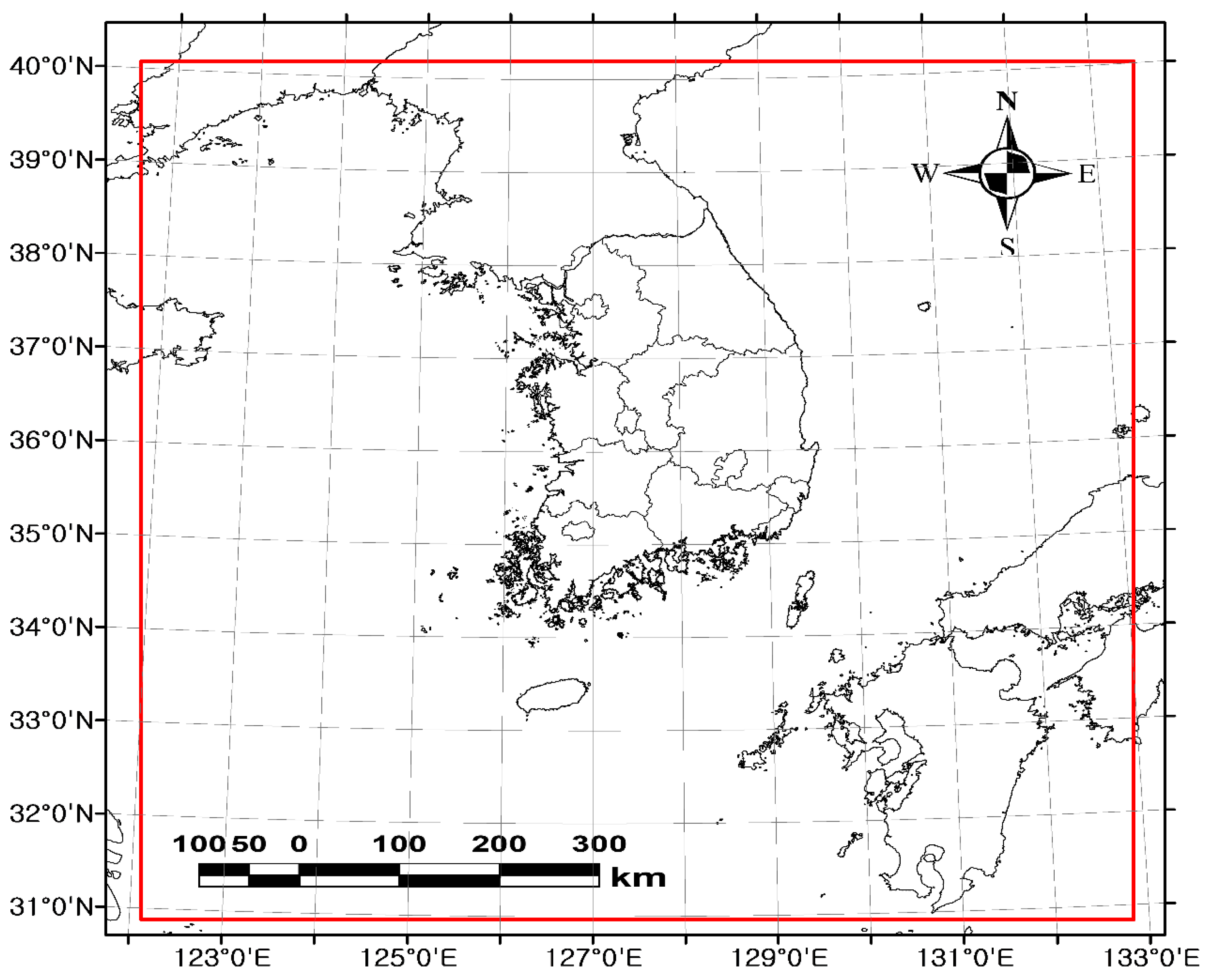
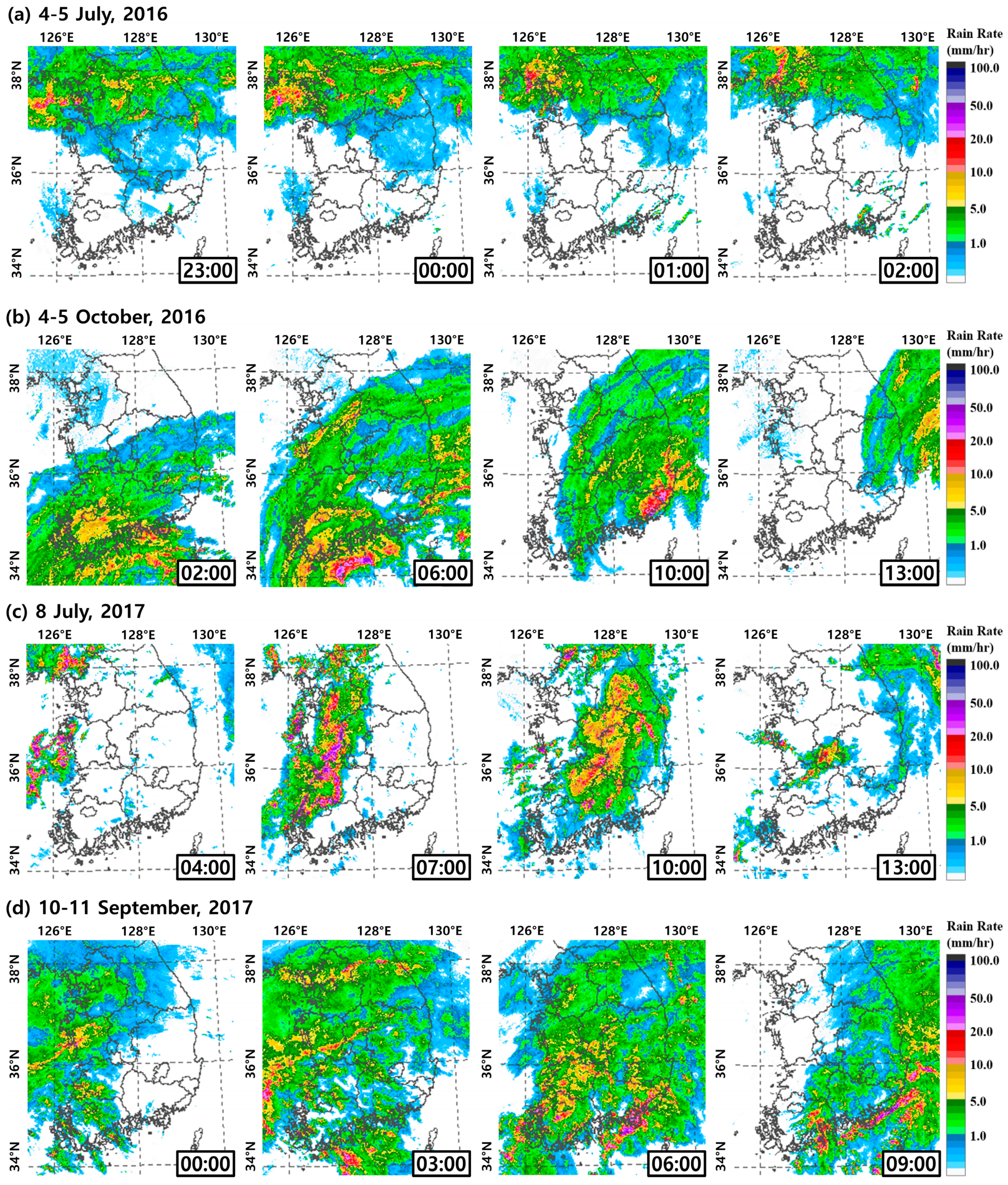
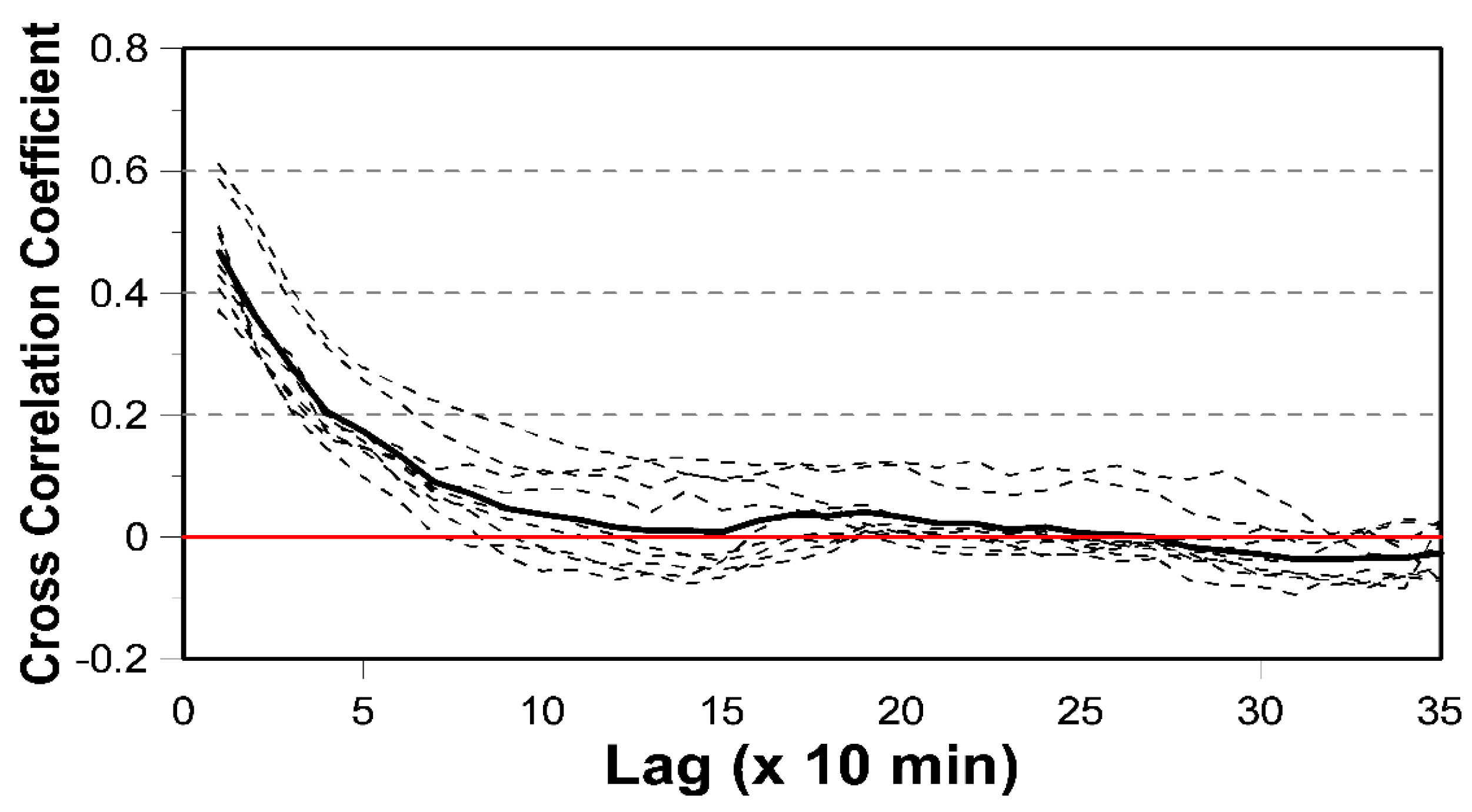
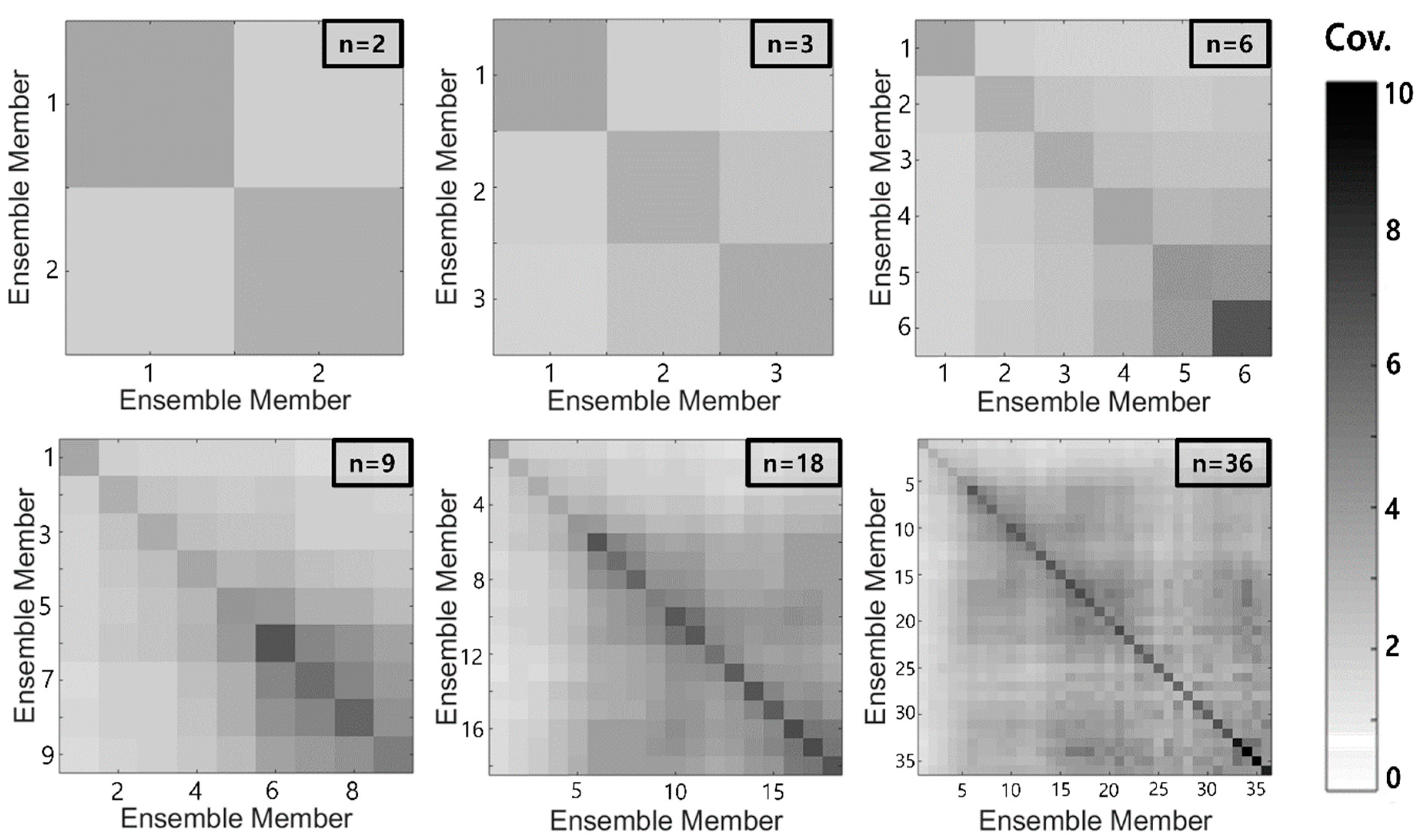

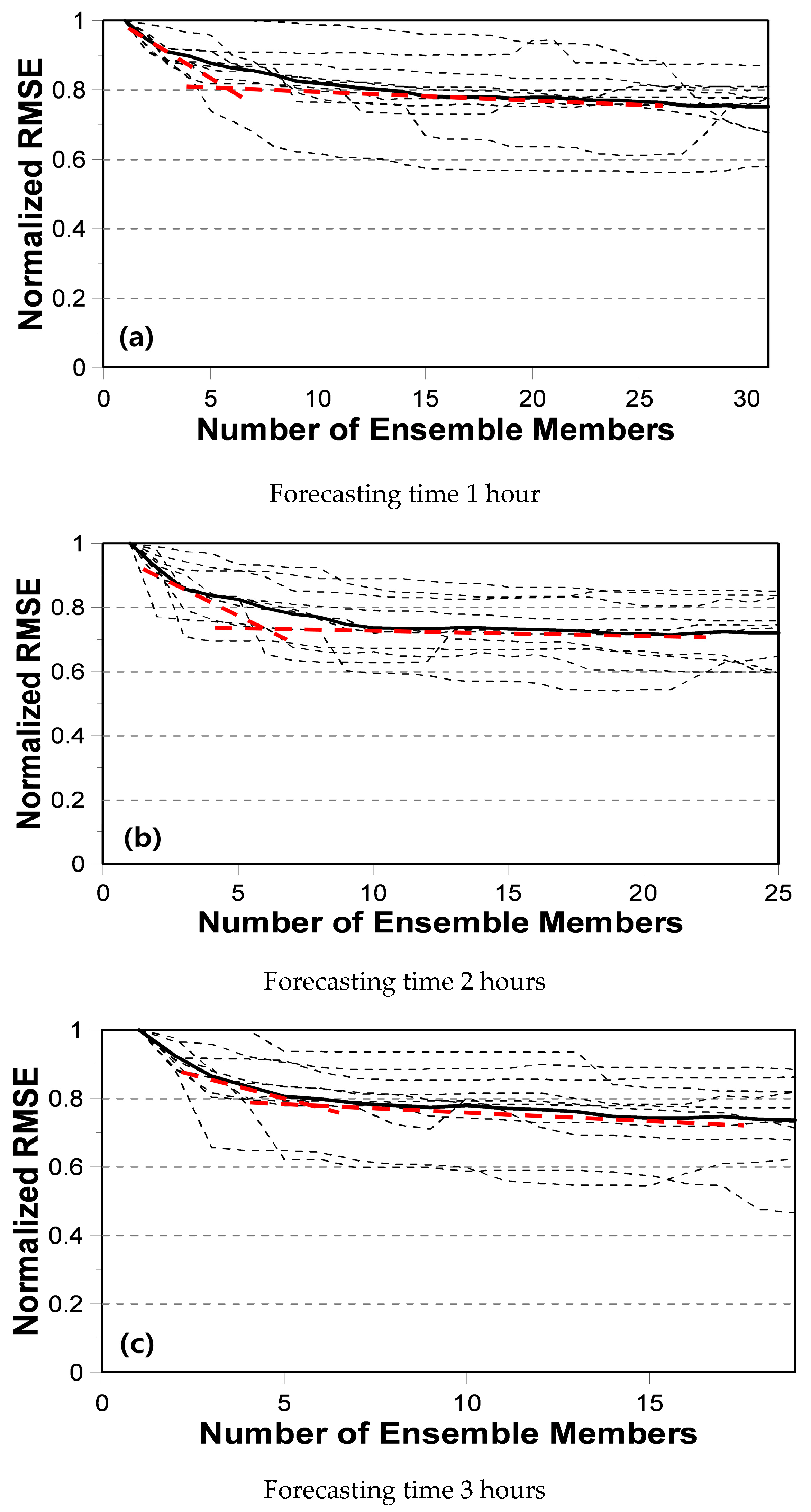
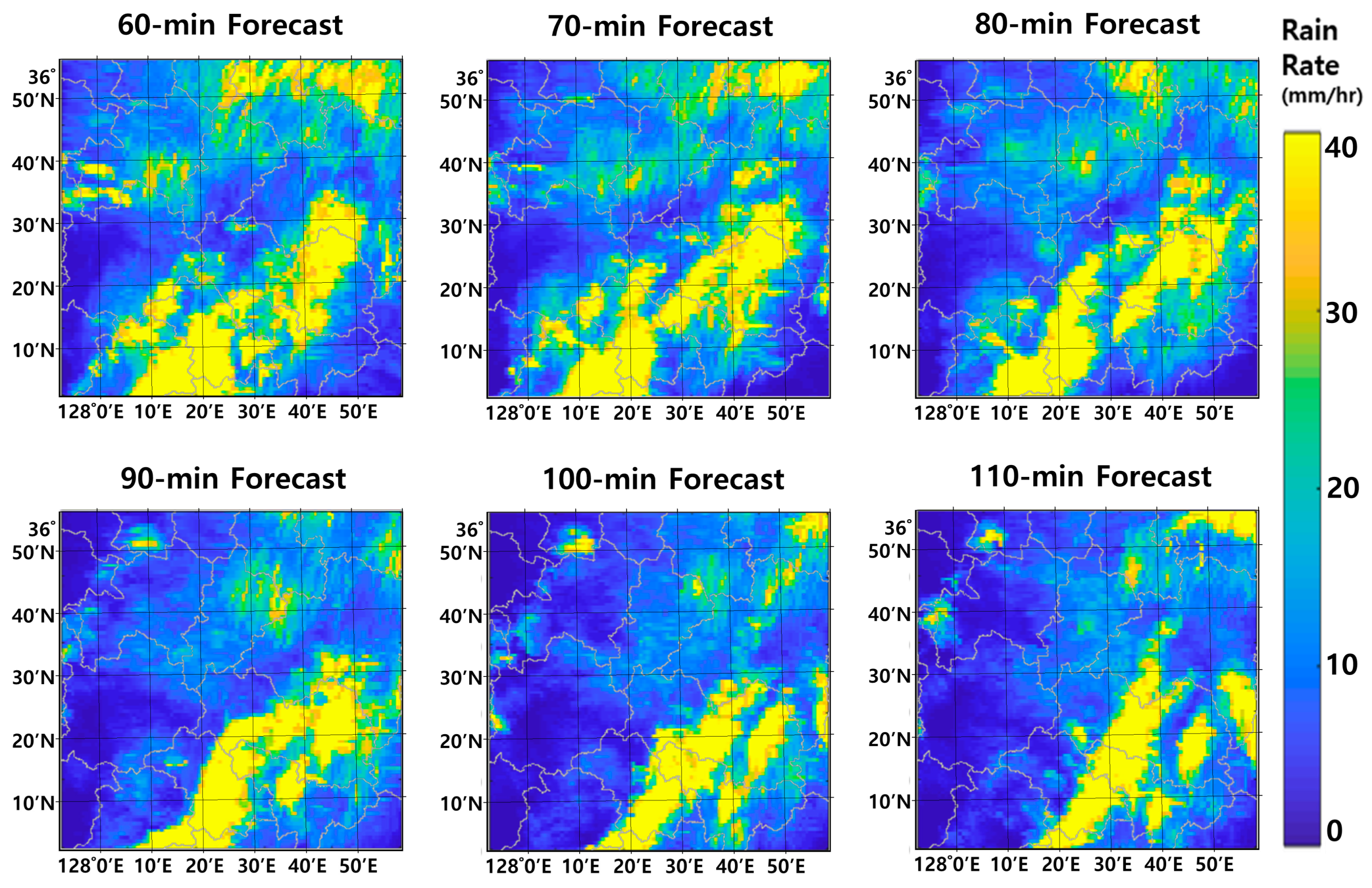
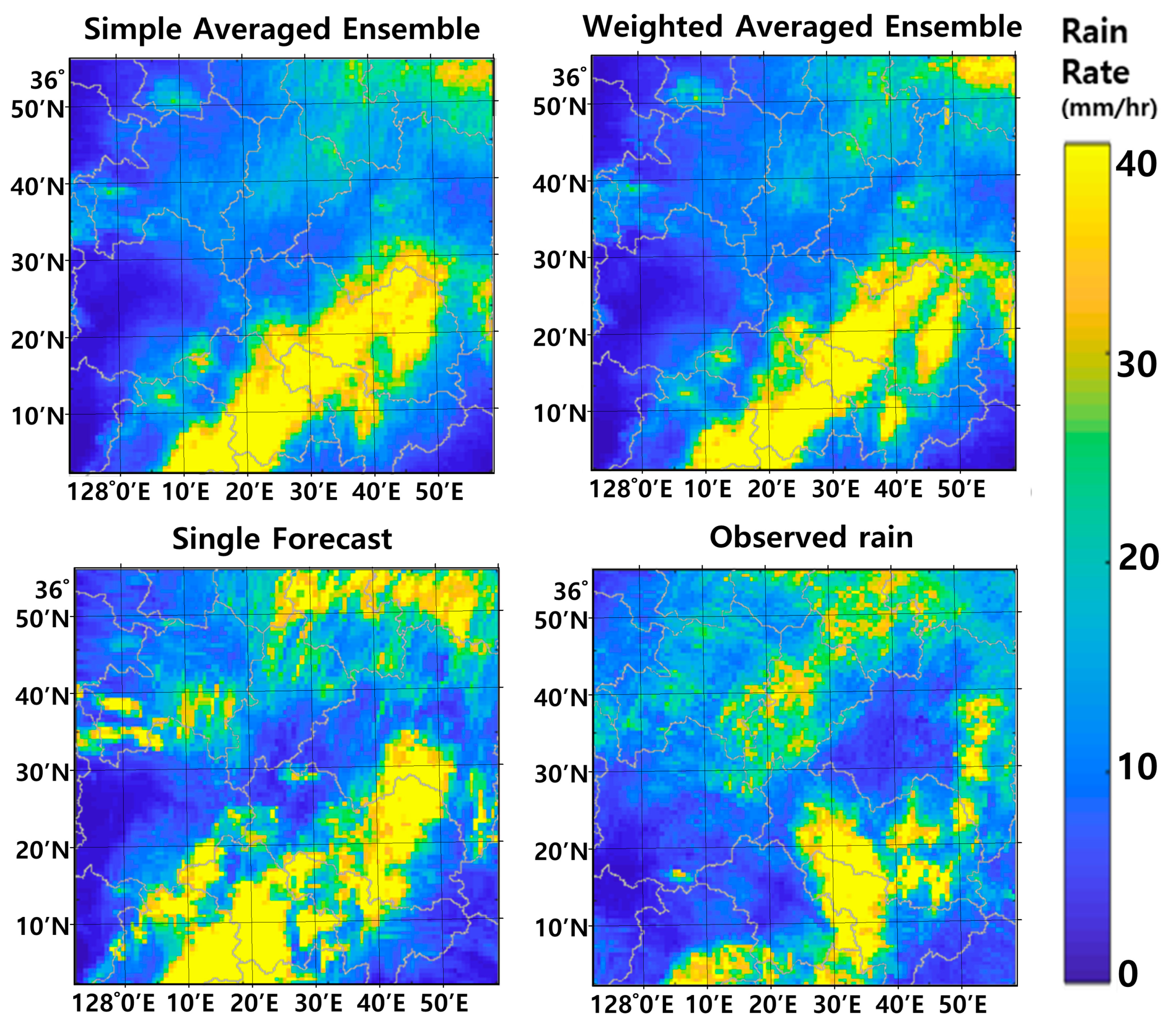
| Characteristics | Storm 1 | Storm 2 | Storm 3 | Storm 4 |
|---|---|---|---|---|
| Dates | 2016/07/04–05 | 2016/10/04–05 | 2017/07/08 | 2017/09/10–11 |
| Duration (hrs) | 20 | 16 | 17 | 13 |
| Maximum rainfall intensity (mm/hr) | 42.8 | 104.2 | 78.9 | 73.4 |
| Type | Monsoon | Typhoon | Monsoon | Typhoon |
| Region | Central | Southern | Central | Southern |
| Direction | ↗ | ↗ | ↘ | → |
| Target times (rainfall intensity) | 07/05 02:30 (42.8 mm/hr) 07/05 03:00 (34.5 mm/hr) | 10/05 08:00 (57.7 mm/hr) 10/05 09:00 (98.3 mm/hr) 10/05 10:00 (104.2 mm/hr) | 07/08 07:00 (66.2 mm/hr) 07/08 08:00 (78.9 mm/hr) 07/08 09:00 (71.2 mm/hr) | 09/11 04:30 (68.1 mm/hr) 09/11 06:00 (73.4 mm/hr) |
| No. | Forecasting Time | ||
|---|---|---|---|
| 1 h | 2 h | 3 h | |
| 1 | 0.3040 | 0.2635 | 0.2465 |
| 2 | 0.1705 | 0.1890 | 0.2450 |
| 3 | 0.1711 | 0.1628 | 0.1739 |
| 4 | 0.1697 | 0.1519 | 0.1475 |
| 5 | 0.1271 | 0.1292 | 0.1058 |
| 6 | 0.0576 | 0.1037 | 0.0813 |
| Measure | Type | Forecasting Time | ||
|---|---|---|---|---|
| 1 h | 2 h | 3 h | ||
| R | Single forecast | 0.25 | 0.31 | 0.09 |
| Ensemble forecast based on the simple arithmetic averaging | 0.39 | 0.25 | 0.09 | |
| Ensemble forecast based on the weighted averaging | 0.42 | 0.30 | 0.13 | |
| RMSE | Single forecast | 9.66 | 8.69 | 10.56 |
| Ensemble forecast based on the simple arithmetic averaging | 7.14 | 7.12 | 8.50 | |
| Ensemble forecast based on the weighted averaging | 6.85 | 6.90 | 8.23 | |
| Measure | Type | Forecasting Time | ||
|---|---|---|---|---|
| 1 h | 2 h | 3 h | ||
| R | Single forecast | 0.26 | 0.19 | 0.18 |
| Ensemble forecast based on the simple arithmetic averaging | 0.27 | 0.21 | 0.19 | |
| Ensemble forecast based on the weighted averaging | 0.27 | 0.22 | 0.20 | |
| RMSE | Single forecast | 7.05 | 7.95 | 8.20 |
| Ensemble forecast based on the simple arithmetic averaging | 6.07 | 6.29 | 6.53 | |
| Ensemble forecast based on the weighted averaging | 5.97 | 6.36 | 6.57 | |
© 2019 by the authors. Licensee MDPI, Basel, Switzerland. This article is an open access article distributed under the terms and conditions of the Creative Commons Attribution (CC BY) license (http://creativecommons.org/licenses/by/4.0/).
Share and Cite
Na, W.; Yoo, C. Optimize Short-Term Rainfall Forecast with Combination of Ensemble Precipitation Nowcasts by Lagrangian Extrapolation. Water 2019, 11, 1752. https://doi.org/10.3390/w11091752
Na W, Yoo C. Optimize Short-Term Rainfall Forecast with Combination of Ensemble Precipitation Nowcasts by Lagrangian Extrapolation. Water. 2019; 11(9):1752. https://doi.org/10.3390/w11091752
Chicago/Turabian StyleNa, Wooyoung, and Chulsang Yoo. 2019. "Optimize Short-Term Rainfall Forecast with Combination of Ensemble Precipitation Nowcasts by Lagrangian Extrapolation" Water 11, no. 9: 1752. https://doi.org/10.3390/w11091752
APA StyleNa, W., & Yoo, C. (2019). Optimize Short-Term Rainfall Forecast with Combination of Ensemble Precipitation Nowcasts by Lagrangian Extrapolation. Water, 11(9), 1752. https://doi.org/10.3390/w11091752






